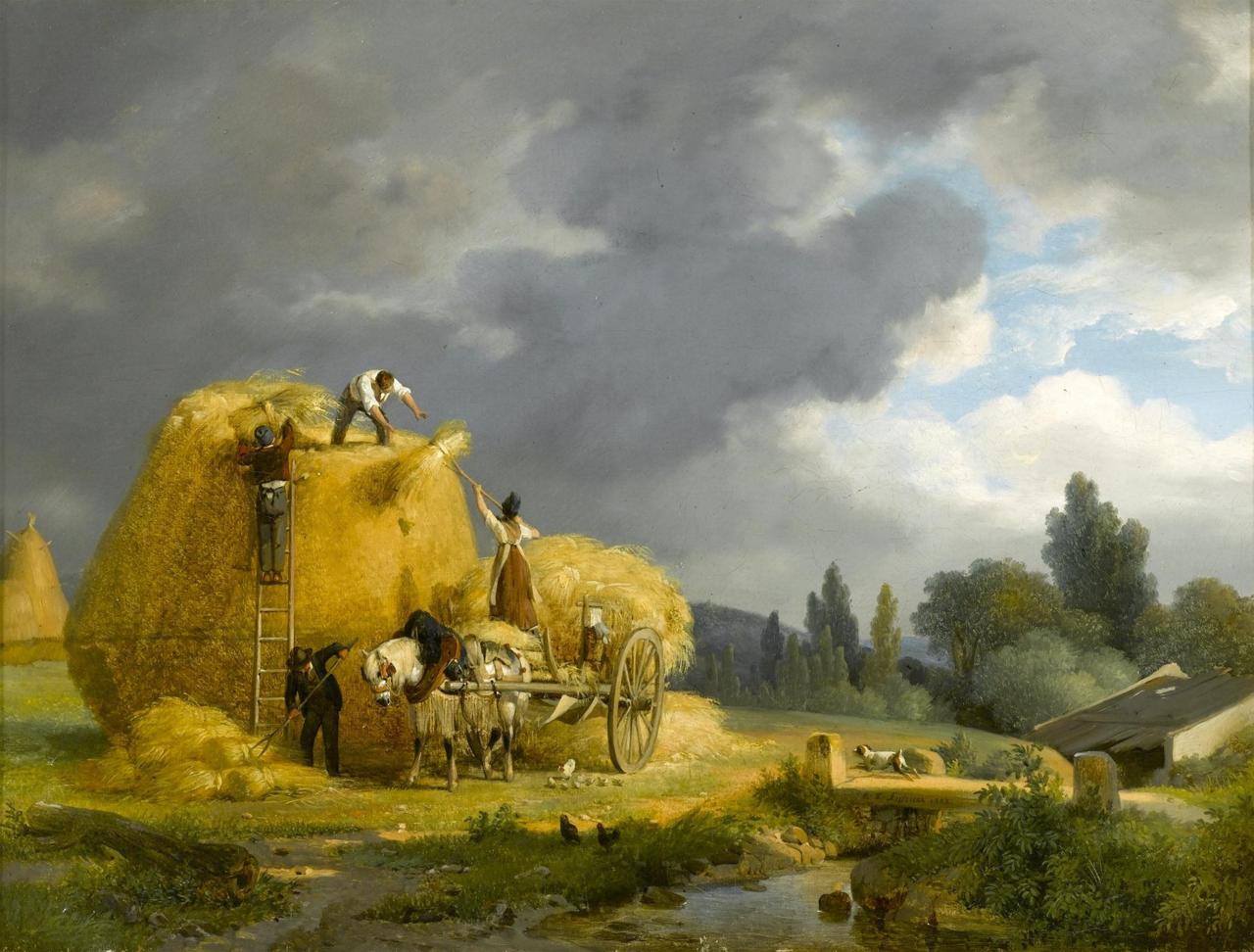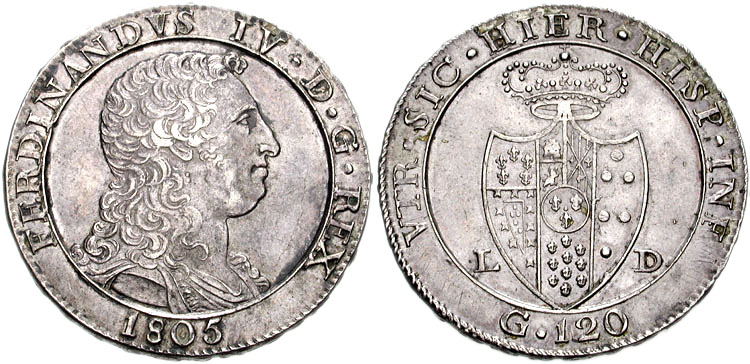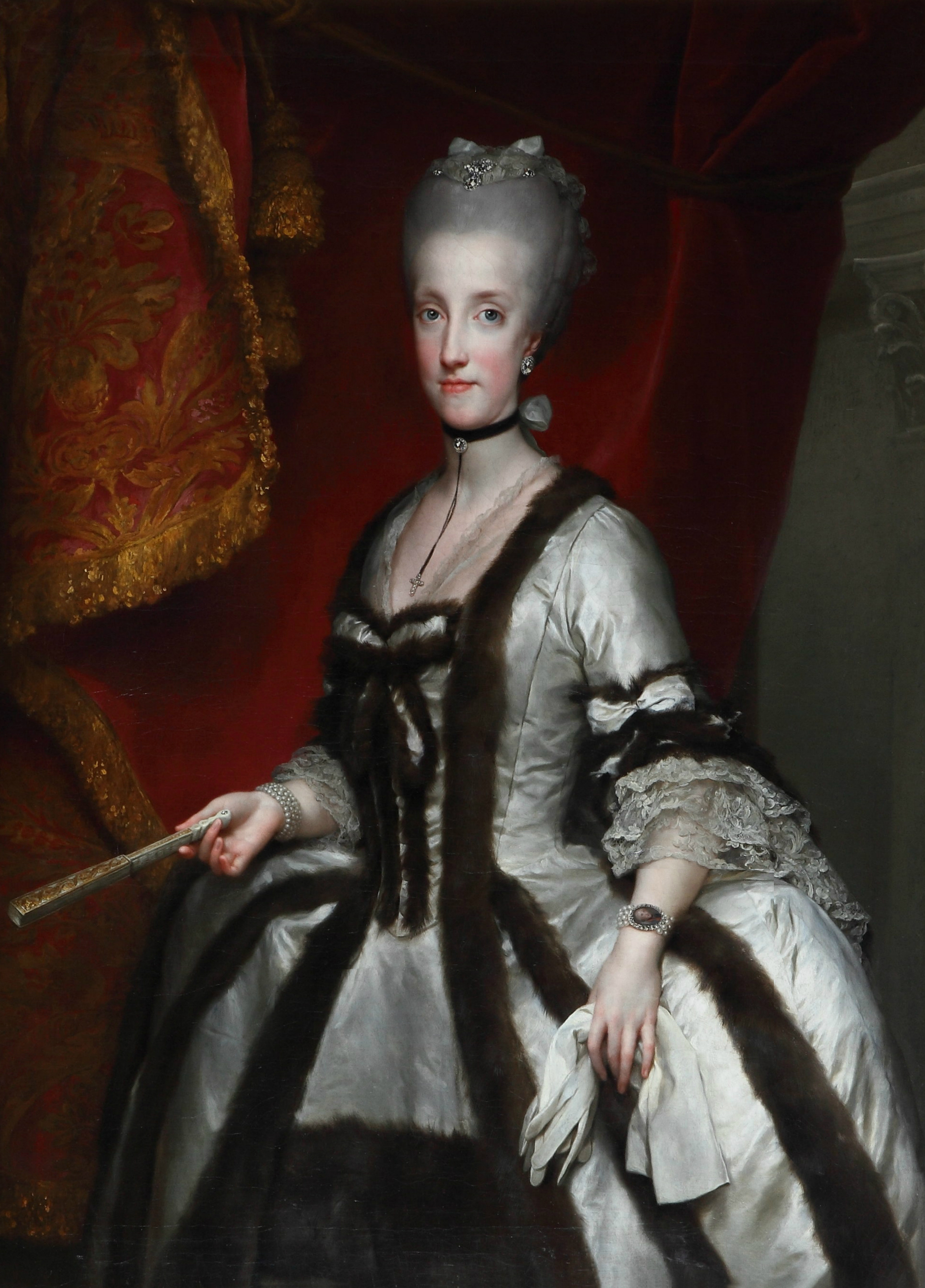|
Marie-Caroline De Bourbon-Sicile, Duchess De Berry
french: Marie Caroline Ferdinande Louise , house = Bourbon-Two Sicilies , father = Francis I of the Two Sicilies , mother = Archduchess Maria Clementina of Austria , religion = Roman Catholicism , signature = Italian signature of Maria Carolina, Duchess of Berry in 1861.png Marie-Caroline of Bourbon-Two Sicilies, Duchess of Berry (Maria Carolina Ferdinanda Luise; 5 November 1798 – 16 April 1870) was an Italian princess of the House of Bourbon who married into the French royal family, and was the mother of Henri, Count of Chambord. Life Caroline was born at Caserta Palace in Naples. She was the eldest child of Prince Francesco, the future King Francis I of the Two Sicilies and his first wife, Archduchess Maria Clementina of Austria, the tenth child and third daughter of Leopold II, Holy Roman Emperor and Maria Luisa of Spain. Her parents were double first cousins. Caroline was baptised with the names of her paternal grandparents, Maria Carolina of Austria and King Ferdina ... [...More Info...] [...Related Items...] OR: [Wikipedia] [Google] [Baidu] |
Duchess Of Berry
Duke of Berry (french: Duc de Berry) or Duchess of Berry (french: Duchesse de Berry) was a title in the Peerage of France. The Duchy of Berry, centred on Bourges, was originally created as an appanage for junior members of the French royal family and was frequently granted to female royals. The style Duke of Berry was later granted by several Bourbon monarchs to their grandsons. The last official Duke of Berry was Charles Ferdinand of Artois, son of Charles X. The title Duke of Berry is currently used as a courtesy title by Prince Alphonse de Bourbon, son of the Legitimist Pretender to the French Throne Louis Alphonse de Bourbon. House of Valois (1360-1505) On October 1360, King John II created the peerage-duchy of Berry as an appanage for his third-born son, John of Poitiers, perhaps on the occasion of his marriage with Joan of Armagnac. Upon his death in 1416, John of Poitiers was succeeded as Duke of Berry by his grandnephew John, Dauphin of France (having been predeceased i ... [...More Info...] [...Related Items...] OR: [Wikipedia] [Google] [Baidu] |
Archduchess Maria Clementina Of Austria
Maria Clementina of Austria (24 April 1777 – 15 November 1801) was an Austrian archduchess and the tenth child and third daughter of Leopold II, Holy Roman Emperor and Maria Luisa of Spain. In 1797 she married her first cousin Prince Francis, Duke of Calabria, heir to the kingdoms of Naples and Sicily. She was modest, well educated and kind, becoming popular in her adoptive country.Acton, ''The Bourbons of Naples'', p. 463 Afflicted with frail health, she died of tuberculosis, age twenty four. Her only surviving child was Princess Caroline, Duchess of Berry. Early life Archduchess Maria Clementina was born at the Villa del Poggio Imperiale, then located in the Grand Duchy of Tuscany, which had been ruled by her father Leopold I, Grand Duke of Tuscany (later Holy Roman Emperor) since 1765. She was named after Prince Clemens Wenceslaus of Saxony, her mother's uncle and brother of Maria Amalia of Saxony, Maria Clementina's maternal grandmother. Her father was a son of E ... [...More Info...] [...Related Items...] OR: [Wikipedia] [Google] [Baidu] |
Élysée Palace
The Élysée Palace (french: Palais de l'Élysée; ) is the official residence of the President of the French Republic. Completed in 1722, it was built for nobleman and army officer Louis Henri de La Tour d'Auvergne, who had been appointed Governor of Île-de-France in 1719. It is located on the Rue du Faubourg Saint-Honoré near the Champs-Élysées in the 8th arrondissement of Paris, the name Élysée deriving from the Elysian Fields, the place of the blessed dead in Greek mythology. Important foreign visitors are hosted at the nearby Hôtel de Marigny, a palatial residence. The palace has been the home of personalities such as Madame de Pompadour (1721–1764), Nicolas Beaujon (1718–1786), Bathilde d'Orléans (1750–1822), Joachim Murat (1767–1815) and Charles Ferdinand, Duke of Berry (1778–1820). On 12 December 1848 under the Second Republic the French Parliament passed a law declaring the building the official residence of the President of France. The Élysée Pal ... [...More Info...] [...Related Items...] OR: [Wikipedia] [Google] [Baidu] |
Louis XVIII Of France
Louis XVIII (Louis Stanislas Xavier; 17 November 1755 – 16 September 1824), known as the Desired (), was King of France from 1814 to 1824, except for a brief interruption during the Hundred Days in 1815. He spent twenty-three years in exile: during the French Revolution and the First French Empire (1804–1814), and during the Hundred Days. Until his accession to the throne of France, he held the title of Count of Provence as brother of King Louis XVI. On 21 September 1792, the National Convention abolished the monarchy and deposed Louis XVI, who was later executed by guillotine. When his young nephew Louis XVII died in prison in June 1795, the Count of Provence proclaimed himself (titular) king under the name Louis XVIII. Following the French Revolution and during the Napoleonic era, Louis XVIII lived in exile in Prussia, England, and Russia. When the Sixth Coalition finally defeated Napoleon in 1814, Louis XVIII was placed in what he, and the French royalists, con ... [...More Info...] [...Related Items...] OR: [Wikipedia] [Google] [Baidu] |
Kingdom Of The Two Sicilies
The Kingdom of the Two Sicilies ( it, Regno delle Due Sicilie) was a kingdom in Southern Italy from 1816 to 1860. The kingdom was the largest sovereign state by population and size in Italy before Italian unification, comprising Sicily and all of the Italian Peninsula south of the Papal States, which covered most of the area of today's Mezzogiorno. The kingdom was formed when the Kingdom of Sicily merged with the Kingdom of Naples, which was officially also known as the Kingdom of Sicily. Since both kingdoms were named Sicily, they were collectively known as the "Two Sicilies" (''Utraque Sicilia'', literally "both Sicilies"), and the unified kingdom adopted this name. The king of the Two Sicilies was overthrown by Giuseppe Garibaldi in 1860, after which the people voted in a plebiscite to join the Savoyard Kingdom of Sardinia. The annexation of the Kingdom of the Two Sicilies completed the first phase of Italian unification, and the new Kingdom of Italy was proclaimed in 1 ... [...More Info...] [...Related Items...] OR: [Wikipedia] [Google] [Baidu] |
Pierre Louis Jean Casimir De Blacas
Pierre-Louis Jean Casimir, Count of Blacas d'Aulps (10 January 1771 – 17 November 1839), later created 1st Duke of Blacas (1821), was a French antiquarian, nobleman and diplomat during the Bourbon Restoration. Biography Early life He was baptized at Avignon on 11 January 1771. He was the son of an aristocrat from Provence and took an opposing view of the French Revolution. In 1790, while a sous-lieutenant in the Noailles dragoons from Tarn, he fled across the Var to Nice in the Kingdom of Sardinia. From there, he went to the German frontier town of Coblenz and joined the counter-revolutionary ''Ă©migrĂ©'' army of Louis XVI's cousin, the Prince of CondĂ©. Later, he went through Italy before entering the service of Russia and fighting the French Republic in Switzerland under Alexander Suvorov. Serving the Bourbons While in the pay of Austria, he then travelled to Warsaw and rejoined the court-in-exile of the pretender to the throne of France, King Louis XVI's younger brot ... [...More Info...] [...Related Items...] OR: [Wikipedia] [Google] [Baidu] |
Maria Isabella Of Spain
Maria may refer to: People * Mary, mother of Jesus * Maria (given name), a popular given name in many languages Place names Extraterrestrial *170 Maria, a Main belt S-type asteroid discovered in 1877 *Lunar maria (plural of ''mare''), large, dark basaltic plains on Earth's Moon Terrestrial *Maria, Maevatanana, Madagascar *Maria, Quebec, Canada * Maria, Siquijor, the Philippines *MarĂa, Spain, in Andalusia *ĂŽles Maria, French Polynesia *MarĂa de Huerva, Aragon, Spain *Villa Maria (other) Arts, entertainment, and media Films * ''Maria'' (1947 film), Swedish film * ''Maria'' (1975 film), Swedish film * ''Maria'' (2003 film), Romanian film * ''Maria'' (2019 film), Filipino film * ''Maria'' (2021 film), Canadian film directed by Alec Pronovost * ''Maria'' (Sinhala film), Sri Lankan upcoming film Literature * ''MarĂa'' (novel), an 1867 novel by Jorge Isaacs * ''Maria'' (Ukrainian novel), a 1934 novel by the Ukrainian writer Ulas Samchuk * ''Maria'' (play), a 1935 play ... [...More Info...] [...Related Items...] OR: [Wikipedia] [Google] [Baidu] |
Palermo
Palermo ( , ; scn, Palermu , locally also or ) is a city in southern Italy, the capital (political), capital of both the autonomous area, autonomous region of Sicily and the Metropolitan City of Palermo, the city's surrounding metropolitan province. The city is noted for its history, culture, architecture and gastronomy, playing an important role throughout much of its existence; it is over 2,700 years old. Palermo is in the northwest of the island of Sicily, by the Gulf of Palermo in the Tyrrhenian Sea. The city was founded in 734 BC by the Phoenicians as ("flower"). Palermo then became a possession of Carthage. Two ancient Greeks, Greek ancient Greek colonization, colonies were established, known collectively as ; the Carthaginians used this name on their coins after the 5th centuryBC. As , the town became part of the Roman Republic and Roman Empire, Empire for over a thousand years. From 831 to 1072 the city was under History of Islam in southern Italy, Arab ru ... [...More Info...] [...Related Items...] OR: [Wikipedia] [Google] [Baidu] |
Ferdinand I Of The Two Sicilies
Ferdinand I (12 January 1751 – 4 January 1825) was the King of the Two Sicilies from 1816, after his restoration following victory in the Napoleonic Wars. Before that he had been, since 1759, Ferdinand IV of the Kingdom of Naples and Ferdinand III of the Kingdom of Sicily. He was also King of Gozo. He was deposed twice from the throne of Naples: once by the revolutionary Parthenopean Republic for six months in 1799 and again by Napoleon in 1805, before being restored in 1816. Ferdinand was the third son of King Charles VII of Naples and V of Sicily by his wife, Maria Amalia of Saxony. On 10 August 1759, Charles succeeded his elder brother, Ferdinand VI, becoming King Charles III of Spain, but treaty provisions made him ineligible to hold all three crowns. On 6 October, he abdicated his Neapolitan and Sicilian titles in favour of his third son, because his eldest son Philip had been excluded from succession due to imbecility and his second son Charles was heir-apparent to the S ... [...More Info...] [...Related Items...] OR: [Wikipedia] [Google] [Baidu] |
Maria Carolina Of Austria
Maria Carolina Louise Josepha Johanna Antonia (13 August 1752 – 8 September 1814) was List of consorts of Naples, Queen of Naples and List of Sicilian consorts, Sicily as the wife of King Ferdinand I of the Two Sicilies. As ''de facto'' ruler of her husband's kingdoms, Maria Carolina oversaw the promulgation of many reforms, including the revocation of the ban on Freemasonry, the enlargement of the navy under her favorite, Sir John Acton, 6th Baronet, Sir John Acton and the expulsion of Spanish influence. She was a proponent of enlightened absolutism until the advent of the French Revolution, when, in order to prevent its ideas gaining currency, she made Naples a police state. Born an archduchess of Austria, the thirteenth child of Empress Maria Theresa and Francis I, Holy Roman Emperor, Emperor Francis I, Maria Carolina married Ferdinand as part of an Austrian alliance with Spain, of which Charles III of Spain, Ferdinand's father was king. Following the birth of a male heir in ... [...More Info...] [...Related Items...] OR: [Wikipedia] [Google] [Baidu] |
Maria Luisa Of Spain
Infanta Maria Luisa of Spain (Spanish: ''MarĂa Luisa'', German: ''Maria Ludovika''; 24 November 1745 – 15 May 1792) was Holy Roman Empress, German Queen, Queen of Hungary and Bohemia, and Grand Duchess of Tuscany as the spouse of Leopold II, Holy Roman Emperor. Early life Maria Luisa was born in Portici, in Campania, the site of the summer palace ('' Reggia di Portici'') of her parents, Charles, King of Naples and Sicily, and Maria Amalia of Saxony. She was the fifth daughter, and second surviving child, of her parents. Her father, the future Charles III of Spain, had become King of Naples and Sicily in 1735 after its occupation by the Spanish in the War of Polish Succession. After her father became King of Spain at the death of her half-uncle, Ferdinand VI of Spain, in 1759, she became known as ''Infanta Maria Luisa of Spain'', and she moved with her family to Spain. Grand Duchess of Tuscany Maria Luisa was originally intended to marry the future Emperor Joseph II, but thi ... [...More Info...] [...Related Items...] OR: [Wikipedia] [Google] [Baidu] |
Leopold II, Holy Roman Emperor
, house =Habsburg-Lorraine , father = Francis I, Holy Roman Emperor , mother = Maria Theresa of Hungary and Bohemia , religion =Roman Catholicism , succession1 =Grand Duke of Tuscany , reign1 =18 August 1765 – 22 July 1790 , predecessor1 = Francis Stephen , successor1 = Ferdinand III , date of burial = , place of burial =Imperial Crypt , signature =Signatur Leopold II. (HRR).PNG Leopold II (Peter Leopold Josef Anton Joachim Pius Gotthard; 5 May 1747 – 1 March 1792) was Holy Roman Emperor, King of Hungary and Bohemia, and Archduke of Austria from 1790 to 1792, and Grand Duke of Tuscany from 1765 to 1790. He was a son of Empress Maria Theresa and her husband, Emperor Francis I, and the brother of Marie Antoinette, Queen of France, Maria Carolina, Queen of Naples, Maria Amalia, Duchess of Parma, and Joseph II, Holy Roman Emperor. Leopold was a moderate proponent of enlightened absolutism. He granted the Academ ... [...More Info...] [...Related Items...] OR: [Wikipedia] [Google] [Baidu] |








